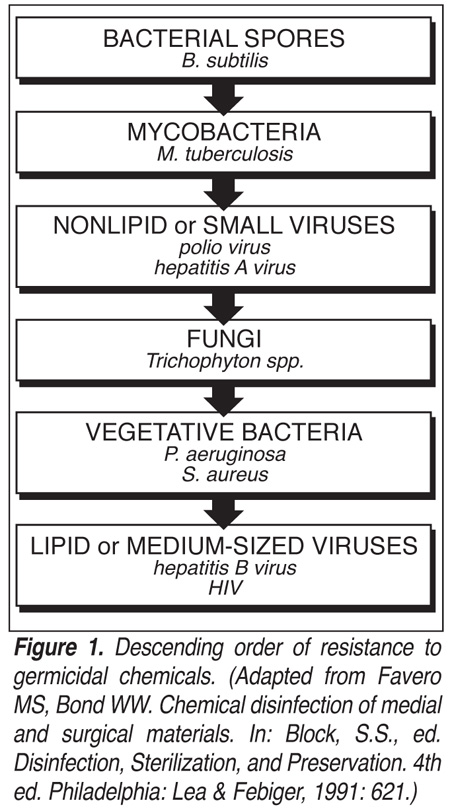The process of hard surface disinfecting is an integral component of a comprehensive cleaning protocol in the food processing and foodservice industries. Its use and purpose is twofold. First, disinfectant is used to lower the initial bioburden of a contaminated surface and render it “safe,” generally from a public health perspective (in other words, the definition of sanitization). Second, it is used as a cleaning adjunct to ensure that the final bioburden is several orders of magnitude lower than can be reasonably expected by the cleaning processes, thereby lowering the risk of transferring microorganisms to the finished product. This latter is the purpose for which disinfectants are most often used in the food industry applications.
Disinfection, by its classical definition, describes a process that eliminates many or all microorganisms on inanimate objects with the exception of bacterial endospores. Although disinfectant chemistry and environmental microbiological techniques have broadened this definition, it nonetheless remains part of a cleaning process. Sanitization is defined as disinfection with a number attached. In other words, the number might be zero if the goal is “no Listeria,” or it may be “X’ number of fecal organisms below infectious dose.” The number is set at some measurement below what we term as “safe” as a matter of public health.
Even with a renaissance in the art and science of disinfecting, and particularly with the advent of the clean room in some food processing plants, this portion of the cleaning process remains somewhat of an enigma. Often, we do not set priorities—either on prevention or on the objectives of cleaning when a disinfectant agent is involved. To this end, it is safe to say that no other economic poison is so poorly understood, so over-used and otherwise so universally inappropriately applied as a hard surface disinfectant. For example, disinfectants, which fall under Federal Insecticide, Fungicide and Rodenticide Act (FIFRA) mandates, differ from any other class of chemicals in that these are the only ones for which you do not receive a material safety data sheet (MSDS) with the product. All of the information that one would typically find on a chemical MSDS is found on the label of disinfectant or sanitizer products, including the U.S. Environmental Protection Agency (EPA) registry number. Believe it or not, there are many in the industry who do not read the labels of the disinfectants they use in the plant.
Product testing of hard surface disinfectants for labeling requirements do not necessarily mimic conditions in the field, and yet we rely on these agents to grant us freedom from litigation without assessing their role as other than a single component within an environmental microbiological process. When we test the disinfectants and sanitizers that are used in the food industry, it is done using penny rings, which is an AOAC International method as specified by EPA. We coat the penny ring with organisms, let it dry, place it in the disinfectant for 10 seconds, and place it into a neutralizing media in the hope that nothing is going to grow out. However, when we use these in the field, we are not only dealing with the control of organisms, but also just about everything that might exist on a hard surface in the plant, including leftover fats, proteins, carbohydrate materials, general soiling and salts. The question, then, is how does one translate the penny ring test to a field application, since they are totally different? The answer is we don’t. However, the trick to good disinfecting in the plant is selecting the product carefully by asking as many questions as possible.
The fact is that the use of disinfectants or sanitizers is basically a due diligence action. Can you achieve a level of sanitization without these products? The answer is absolutely yes. The clean rooms industry has repeatedly demonstrated that an extremely low bioburden can be achieved by cleaning methods alone. By definition, a disinfecting agent should reduce the bioburden on a clean surface by an additional five orders of magnitude. Therefore, the better we clean, the greater is the effect of the disinfectant or sanitizer. Although you may be able to achieve the identical bioburden with or without disinfection, if a foodborne illness outbreak occurs and you have not used a biocide, you are at risk of litigation. For this reason, it is important to develop a rational approach to selecting and using disinfectants and sanitizers that are appropriate for the food plant or foodservice operation.
How to Manage Expectations
Our expectations of hard surface disinfectants are sometimes unrealistic. For instance, we somehow expect disinfecting agents to provide a “degree” of sterility as a remedial measure, with zero risk of recovering a viable microorganism from the disinfected surface. We deal in probabilities of survival and deny that any survival is permitted. The cidal activity plots of disinfecting agents on semi-log charts do not have a “zero” value, yet we insist on zero chances of survivability; if survivors are found, it is considered a “failure.” We concern ourselves with the survival of an occasional spore, but assess the need for disinfection as a function of expediency, realizing that we do not have to destroy all spores. And finally, we disinfect objects to the nth degree, only to expose them to a contaminating environment and blaming the process if a viable organism is found.
The bottom line is that we rely on a product that says “cleans and disinfects” to an unrealistic degree. Often, we rely on the disinfectant rather than on the cleaning process. We have to get the gross soiling off the hard surfaces first in order for any disinfectant or sanitizer to work properly. The two primary problems are that in many cases we have expectations for the disinfectant beyond that which it can accomplish, and even if the disinfectant works extremely well or to design, our expectation is that it will render sterility when it does not.
All of this does not imply that hard surface disinfectants are bad things or that our expectations are totally unrealistic. Quite the contrary; they are a most valuable tool when used within the proper context of cleaning. Disinfecting agents, when used appropriately can significantly reduce the risk of carrying a viable microorganism on the cleaned and treated surface. Of greatest importance, however, is to consider the primary objectives of contamination control. The first objective is to keep the contaminants out. This means that every effort to prevent initial contamination of the hard surface will determine the final bioburden. The second objective is to eliminate the contaminants that have found their way to the hard surface, in spite of all preventive efforts. This objective characterizes disinfection. Therefore, the more effort and care put into the initial cleaning process with a hard surface, the greater the probability of not recovering a viable microorganism after treatment. For this reason, it is imperative to establish cleaning objectives and priorities. In other words, determine “how clean is clean” before using a disinfecting agent.
Selection and Use
Not all hard surface disinfectants and sanitizers are the same. Aside from the numerous chemistries involved, ranging from a multitude of complex phenols, quaternary ammonium chlorides and a variety of halogen compounds, to various simple alcohol formulations and hydrogen peroxide at the other end of the spectrum, all hard surface disinfectants are meant to be applied to an already clean surface.
Compatibility with that surface, as well as with the cleaning agents that were used to prepare that surface, is an important consideration that cannot be overlooked. First, the compatibility of the cleaning agent with the disinfecting or sanitizing agent must be considered. If these compounds are incompatible, the cleaning agent left on the surface may neutralize the biocide and negate any further reduction of microbial surface contamination. The second issue is the compatibility of the disinfectant with the surface itself There are some excellent disinfectants and sanitizers available and in use in the veterinary and food industries that provide exceptional cleaning of surfaces, but may etch or otherwise ruin the finish of a noncompatible surface, whether metal, plastic or ceramic. As a result, when the surface is no longer smooth, it becomes a much more difficult job to properly clean the surface and the opportunity for biofilm development increases. Remember, the mode of action of disinfectants and sanitizers does something in a negative way to target microorganisms. Likewise, it may also do something in a negative way to surfaces.
Since it is a fact that some disinfectants are not wholly compatible with surface-active agents such as detergents (there are notable exceptions), cleaning may not be as effective in removing the initial soiling if a combined product is used. Remember, too, that all microbial decay takes place in a logical manner. The portions of the number of organisms destroyed are constant with time. Natural decay occurs anytime when the microbe is removed from its “normal” environment. Therefore, “lethal” versus “natural’ decay is a matter of degree. The results you get in comparison testing may be nothing more than a natural phenomenon under the guise of a lethal treatment.
Processors should make sure to read the labels of all cleaning, disinfecting and sanitizing agents to ascertain whether one may neutralize or inhibit the other when used in tandem and to ensure that the product is intended for food contact surfaces. Second, ask the product manufacturer of each chemical agent that you use for a compatibility matrix for their product. Most reputable suppliers have these matrices available to customers, which show the compatibility of their product with particular types of hard surfaces and with other chemicals.
 We also often forget that hard surface disinfecting agents are a class of economic poison, which are controlled in much the same manner and under the same set of regulations as herbicides and pesticides. That which is toxic to microbes also may be toxic to other biological systems. It is therefore prudent not to overkill with a disinfectant. Rather, select a disinfecting agent that demonstrates the lowest level of toxicity. For instance, if the goal is to eliminate most vegetative bacteria and fungi, it is not necessary to use a disinfecting agent powerful enough to kill mycobacteria such as M. tuberculosis or bacterial spores. The following figure shows, in descending order of resistance, the microbial targets of germicidal agents (Figure 1). A disinfectant selected against an organism of known resistance will be effective against organisms lower on the resistance scale.
We also often forget that hard surface disinfecting agents are a class of economic poison, which are controlled in much the same manner and under the same set of regulations as herbicides and pesticides. That which is toxic to microbes also may be toxic to other biological systems. It is therefore prudent not to overkill with a disinfectant. Rather, select a disinfecting agent that demonstrates the lowest level of toxicity. For instance, if the goal is to eliminate most vegetative bacteria and fungi, it is not necessary to use a disinfecting agent powerful enough to kill mycobacteria such as M. tuberculosis or bacterial spores. The following figure shows, in descending order of resistance, the microbial targets of germicidal agents (Figure 1). A disinfectant selected against an organism of known resistance will be effective against organisms lower on the resistance scale.
Other considerations in choosing a disinfectant include the number and type of organisms to be destroyed, as well as numerous environmental conditions such as temperature, pH of the substrate, and realistic contact times. Physical or chemical factors in the surrounding environment being treated, such as compatibility with other cleaning agents, stability and solubility of the disinfecting compounds also deserve equal consideration. In this science, “one size does not fit all” and selecting a single disinfectant for all applications may actually hinder the cleaning process or add an additional cost factor with little or no benefit. For example, if your plant is operating under a zero-tolerance standard for Listeria, it does not make any sense to use a disinfectant that does not list Listeria as one of the agent’s target organisms on the label. Therefore, as part of your selection process, identify those target organisms of concern and determine their approximate number or type of loading that you see through a surface testing program. Once this is done, you then can define your expectations of the biocide you select.
When selecting a disinfecting agent read beyond the manufacturers’ literature. After all, they need to sell product in an unbelievably competitive market. While no one will readily admit to problems encountered with these compounds, virtually everyone will crow with a success. Don’t believe everything you believe; myths and legends abound. For instance, there is no evidence in the scientific literature that microbes develop resistance to hard surface disinfectants. Most of these products kill by coagulating protein in one form or another. The building blocks of life have not advanced to the stage where this mode of action is reversible. What generally happens when the bioburden seems to rise is either ennui on the part of the workers in handling the product in current usage or a change in the type and quality of soiling.
If you have an automated sanitation or disinfectant dispensing system, the system should be properly calibrated. Many automated sanitation system vendors will calibrate and service this equipment for the client. If you are maintaining your own system, it is important to calibrate the system properly according to manufacturer’s protocol. Remember, the label gives the use dilution, which is based on the strength of the chemical, the contact time and the target organisms that the disinfectant will kill. With regard to the use dilution, your application should be based on a written validation protocol. There is a fine line between safe and un-safe. Too much of a biocide can result in a carryover to the food; if you use too little, you are not going to effect the disinfection to the level that you want.
A Clean Finish
Hard surface disinfectants are an integral part of a cleaning protocol. Their use and efficacy are predictable and their selection should be based on good science. Establishing well-defined microbiological end-points through cleaning, with toxicity, economy and ease of use as relevant factors, will make that selection a valuable tool in an overall program of contamination control in the food industry operation.
Robert W. Powitz, Ph.D., MPH, RS, is principal consultant and technical director of Old Saybrook, CT-based P. W Powitz & Associates, a professional corporation of forensic sanitarians who specialize in environmental and public health litigation support services to law firms, insurance companies, governmental agencies and industry For more than 12 years he was the biosafety officer and director of environmental health and safety for Wayne State University in Detroit, Ml. He also served as director of biological safety and environment for the U.S. Department of Agriculture at the Plum Island Animal Disease Center at Greenport, NY Powitz is a Diplomate Laureate in the American Academy of Sanitarians and a Diplomate of the American Board of Forensic Engineering and Technology He can be reached at sanitarian@juno.com or by calling (800) 982-3363.
A Rational Approach to Using and Selecting Hard Surface Dissinfectants and Sanitizers




